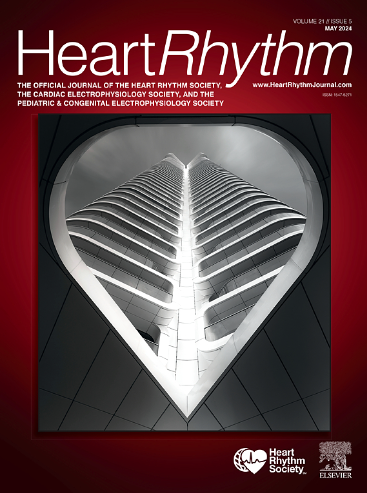经皮球囊静脉成形术治疗症状性铅相关静脉狭窄。
IF 5.7
2区 医学
Q1 CARDIAC & CARDIOVASCULAR SYSTEMS
引用次数: 0
摘要
背景:导联相关静脉狭窄(LRVS)是经静脉导联植入术后的常见病,通常是偶然诊断出来的。引起不适和肿胀的无症状 LRVS 并不常见:报告经皮球囊静脉成形术后无症状 LRVS 患者的管理和预后方法:我们纳入了 2014 年至 2020 年期间在宾夕法尼亚大学医院接受静脉成形术、对超过 30 天的抗凝治疗无反应的无症状 LRVS 患者。如果无法用导线穿过病变部位,则首先进行经静脉导联取出术(TLE):18名患者(平均62±10岁,44%为女性)接受了27次静脉成形术。9例(50%)患者出现手臂肿胀,1例(6%)患者出现面部/颈部肿胀,8例(44%)患者同时出现这两种症状。静脉造影显示,10 例(56%)患者的腋静脉/锁骨下静脉、6 例(33%)患者的肱静脉和 4 例(11%)患者的上腔静脉出现 LRVS。大多数患者(83%)在进行静脉成形术前需要进行TLE,只有5/18(28%)的患者在导联穿过狭窄段时仍然需要进行TLE。13名患者(72%)症状完全缓解,4名患者(22%)因继发性淋巴水肿而部分缓解,1名患者症状无改善。症状完全缓解的患者从症状出现到接受干预的时间较短(195 天对 690 天,P=0.02):结论:LRVS 可影响静脉系统的任何部位,可能表现为手臂、面部/颈部或两者同时肿胀。球囊静脉成形术安全有效,通常需要 TLE,当导线不再穿过狭窄区域时,球囊静脉成形术尤为持久。静脉成形术对继发性淋巴水肿的效果较差,因此需要及时干预。本文章由计算机程序翻译,如有差异,请以英文原文为准。
Percutaneous balloon venoplasty for symptomatic lead-related venous stenosis
Background
Lead-related venous stenosis (LRVS) is common after transvenous lead implantation and generally diagnosed incidentally. Symptomatic LRVS, causing discomfort and swelling, is less common.
Objective
We report on the management and outcomes of patients with symptomatic LRVS after percutaneous balloon venoplasty.
Methods
We included patients with symptomatic LRVS unresponsive to >30 days of anticoagulation who underwent venoplasty at the Hospital of the University of Pennsylvania between 2014 and 2020. Transvenous lead extraction (TLE) was performed first if the lesion could not be crossed with a wire.
Results
Eighteen patients (mean age, 62 ± 10 years; 44% female) underwent 27 venoplasty procedures. Symptoms included arm swelling in 9 (50%), facial/neck swelling in 1 (6%), and both in 8 (44%). Venography revealed LRVS in the axillary/subclavian veins in 10 (56%), the brachiocephalic vein in 6 (33%), and the superior vena cava in 4 (11%). Most patients (83%) required TLE before venoplasty, and only 5 of 18 (28%) remained with leads crossing the stenosed segment. Thirteen patients (72%) had complete symptom resolution, 4 (22%) had partial resolution due to secondary lymphedema, and 1 showed no improvement. Patients with complete resolution had shorter times from symptom onset to intervention (195 vs 690 days; P = .02).
Conclusion
LRVS can affect any part of the venous system and may be manifested with swelling of the arm, face/neck, or both. Balloon venoplasty is safe and effective, often requires TLE, and is particularly durable when leads no longer cross the stenosed region. Venoplasty is less effective for secondary lymphedema, highlighting the need for timely intervention.
求助全文
通过发布文献求助,成功后即可免费获取论文全文。
去求助
来源期刊

Heart rhythm
医学-心血管系统
CiteScore
10.50
自引率
5.50%
发文量
1465
审稿时长
24 days
期刊介绍:
HeartRhythm, the official Journal of the Heart Rhythm Society and the Cardiac Electrophysiology Society, is a unique journal for fundamental discovery and clinical applicability.
HeartRhythm integrates the entire cardiac electrophysiology (EP) community from basic and clinical academic researchers, private practitioners, engineers, allied professionals, industry, and trainees, all of whom are vital and interdependent members of our EP community.
The Heart Rhythm Society is the international leader in science, education, and advocacy for cardiac arrhythmia professionals and patients, and the primary information resource on heart rhythm disorders. Its mission is to improve the care of patients by promoting research, education, and optimal health care policies and standards.
 求助内容:
求助内容: 应助结果提醒方式:
应助结果提醒方式:


